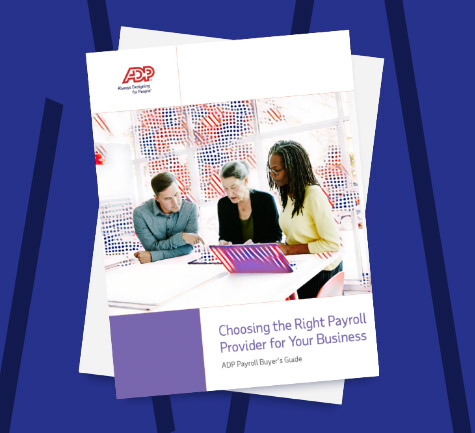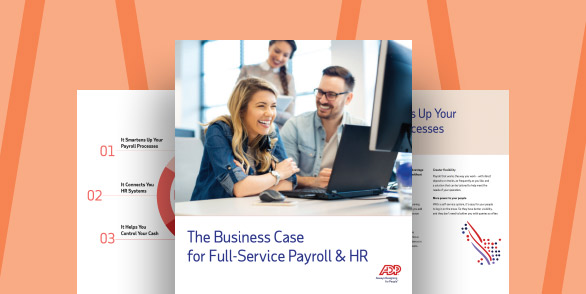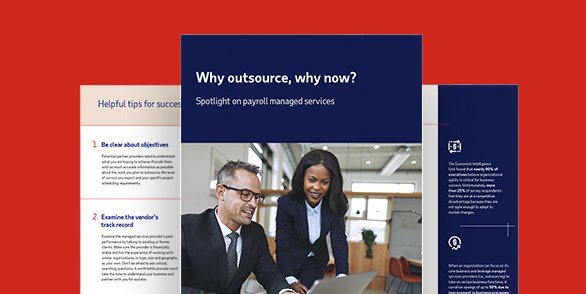The pressure to do more with less is intensifying for many employers today. Their challenge is two-fold. One, the role of payroll teams within organizations is growing amidst a shortage of payroll skills. And two, employers must control administrative costs to boost profit margins. As a result, an increasing number of companies are relying on payroll automation to streamline processes, expedite repetitive tasks and support complex compliance requirements.
Table of Contents
What is automation?
Automation is the process of offloading repetitive, laborious work to a machine or software solution so humans can focus their attention on more critical or strategic activities. For instance, automated tools can make life easier for many people working in accounts receivable. These solutions will review incoming payments, automatically match them against invoices and flag any mismatches that require human intervention.
Automation is also a major aspect of artificial intelligence (AI). Chatbots, for example, are used on many modern websites to help users gather information in a step-by-step, interactive manner. They can answer questions directly, share documents or even connect users with a live support specialist if the request for information goes beyond the bot's library of responses.
What is payroll automation?
Payroll automation is as simple as it sounds. Employers provide their business and employee information to a payroll service provider, who then assists with payroll and tax-filing responsibilities. Such providers generally have proprietary technology that leverages automation.
Once the payroll provider has all the requisite data – employer identification number (EIN), employee withholding certificates, preferred pay periods, etc. – employers have less administrative burden. They need only ensure the supplied information is continually up to date, notify the provider of any changes and approve payroll on time. The provider, meanwhile, manages all back-end operations, including issuing payments, collecting and filing tax payments and preparing employee tax forms at the end of the year.
How does payroll automation work?
Automated payroll is designed to be unobtrusive so employers can go about their day without worrying about employees being paid correctly. Some may not even be aware of the steps that take place. Here’s a peek at what goes on behind the scenes for those who want to know more about the automation of payroll:
- Gross pay is calculated by multiplying an employee’s hourly pay rate by hours worked.
- Pretax deductions, such as contributions to a qualified benefits plan, are withheld from employee pay.
- Statutory deductions for federal income tax, Medicare tax, Social Security tax and state and local taxes are withheld from employee pay.
- Post-tax deductions, such as wage garnishments, are withheld from employee pay.
- Employees receive their net wages via paycheck or electronic payments, where permissible.
- Tax dues are remitted to federal, state and local government agencies.
- Detailed records of all calculations and transactions are saved for the requisite lengths of time.
Payroll automation benefits: Why should payroll be automated?
Small business owners who choose a trusted provider for their payroll automation can expect several valuable benefits, including:
- Security – Because payroll is their primary focus, payroll providers offer services with cutting-edge security that protects the information of their clients and their clients' employees.
- Accuracy – A reputable payroll service will stay updated on the constantly changing rules and regulations to help ensure that withholdings, deductions and tax payments are accurate.
- Cost savings – Reducing errors can help minimize the risk of penalties and fines issued by government agencies for compliance violations.
- Time savings – Automating payroll gives employers more time to perfect their products or services and grow their market share.
For larger businesses with payroll practitioners on staff, the benefits of automation do not negate the need for those individuals. Many employers use the savings in time and resources to shift their payroll team’s focus from administrative tasks to higher-value, knowledge-intensive activities, like the following:
- Integrations of new or emerging technologies
- Business process improvements
- Data analysis
- Strategic planning
How to automate payroll
Payroll automation is a smooth process with the proper preparation. Generally, there are five steps:
- Analyze and document processes
Automating payroll gives employers the chance to identify redundancies or suboptimal processes and refine payroll operations. Areas to cover include:- Different employee classifications (exempt vs non-exempt)
- Different pay frequencies
- Reimbursement for expenses, if done through paychecks
- Benefits deductions
- Data entry and systems integration
- Gather data
- Find out where all the legacy payroll and HR data is stored.
- Review current data and verify its accuracy.
- Have employees update their personal information.
- Map the transfer of legacy data to the automated payroll system.
- Inform third parties
- Benefit providers – Start planning the necessary payroll integration steps with benefits providers.
- Government agencies and unions – Make sure the automated payroll system can integrate the applicable guidelines and business rules.
- Banks – Update the banks from which payroll is drawn.
- Get stakeholder buy-in
- Identify who will be involved in implementing automated payroll and ensure they have the time to do the job right.
- Identify who will administer automated payroll and make them part of the planning and implementation process.
- Establish good communication between internal and external project leads and set expectations and timelines.
- Schedule automated payroll training for administrators and employees.
- Prepare the infrastructure
Employers must ensure their infrastructure can support payroll automation. Asking the payroll service provider about software or hardware requirements is a good place to start. If infrastructure updates are necessary to accommodate system integrations, it may be worth the investment. Improved process efficiencies can quickly pay off.
What to look for in an automated payroll provider
There are dozens of providers on the market offering automated payroll services. Some are more “DIY” than others, so a careful evaluation is necessary. When choosing an automated payroll provider, employers may want to consider these three factors:
- Trust – First and foremost, it’s essential to fully trust the company chosen to automate payroll payments and know they have enough experience to do the job right. Employers must remember that their employees rely on paychecks to earn a living and provide for their families.
- Service integration – Next, employers should evaluate how payroll can be integrated with other parts of their business to be as efficient as possible. Some possible areas of integration to look for include general accounting ledgers, payroll-related benefits (insurance deductions, retirement savings contributions, etc.) and employee time tracking.
- Value – Finally, employers must consider the overall value they’ll receive from the automated payroll provider. Cost is important, but so are customer support services, integrations and the availability of related solutions, like benefits administration and time and attendance.
What are the limits of payroll automation?
Not all automated payroll services are equal, and some may have limitations. If employers find that payroll still demands too much of their time even after automating the process, they should ask the provider why. Workdays are too short to compensate for an outdated or inefficient process. Ultimately, automated payroll should deliver the ability to process payroll from any device, anywhere.
Manual payroll vs. automated payroll
Many HR teams continue to spend their day on manual payroll tasks that could easily be automated or handed over to external providers. Consequently, they are often less effective in leading their organization forward and achieving core business objectives.
Automation, in contrast, frees people from administrative burdens so they can apply their skills and experiences to the more knowledge-intensive parts of their job. They become more engaged, more productive and are more likely to remain with the organization.
The future of payroll automation
AI is poised to transform payroll processing over the next two to three years. Adopting this technology will help payroll practitioners find new operational efficiencies and achieve more in less time. ADP, for example, has rolled out AI error detection that flags potential payroll mistakes before they happen.
However, the successful deployment of AI relies on companies embracing it at all levels of the organization. Mandates by senior leadership or IT teams may not be enough to drive adoption. Those who will manage the use of AI solutions within their teams must be on board with the technology and understand its outputs.
Payroll automation case study
The owners of a small automotive repair shop didn’t need a payroll solution when it was just them. But as they grew and hired employees, they realized that not knowing how to run payroll could hurt them. They turned to ADP for payroll automation, and it took a huge weight off their shoulders each week. All they had to do was gather their employees’ hours, and ADP’s automated payroll service took care of the rest.
Frequently asked questions about payroll automation
When should I start using payroll automation software?
The ideal time to automate payroll is when the first employee is hired. If automation is not economically feasible at that time, employers should outsource payroll as soon as they experience enough business growth to afford the service. Doing so helps reduce the risk of payroll errors and expensive penalties.
What kind of payroll platform is best for my business?
Most businesses run payroll, but not every payroll management solution offers the same levels of function, service and reliability. A provider with best-in-class technology generally delivers the following:
- Assists with compliance requirements in every place the organization does business
- Integrates well with other software systems and keeps data secure
- Comes with expert support to help ensure everything works smoothly
- Helps reduce the costs and time of payroll administration
- Facilitates flexible payment options for employees
What software integrations are important for automated payroll software to run smoothly?
Integrating payroll with related functions eliminates duplicate data entry and helps reduce errors. Some of the more common integrations that make life easier for employers include:
- Time and attendance
- General accounting ledgers
- Insurance benefits
- Retirement savings plans
Will payroll be replaced by AI?
Generative AI is meant to complement payroll and HR functions, not replace them. It addresses workers’ real-world needs and understands their intentions so they don’t have to struggle with complicated processes. Weaving AI into payroll, people analytics, recruitment, talent management and benefits can help employers drive better results and experiences for their employees.
This article is intended to be used as a starting point in analyzing what is automated payroll and is not a comprehensive resource of requirements. It offers practical information concerning the subject matter and is provided with the understanding that ADP is not rendering legal or tax advice or other professional services.





